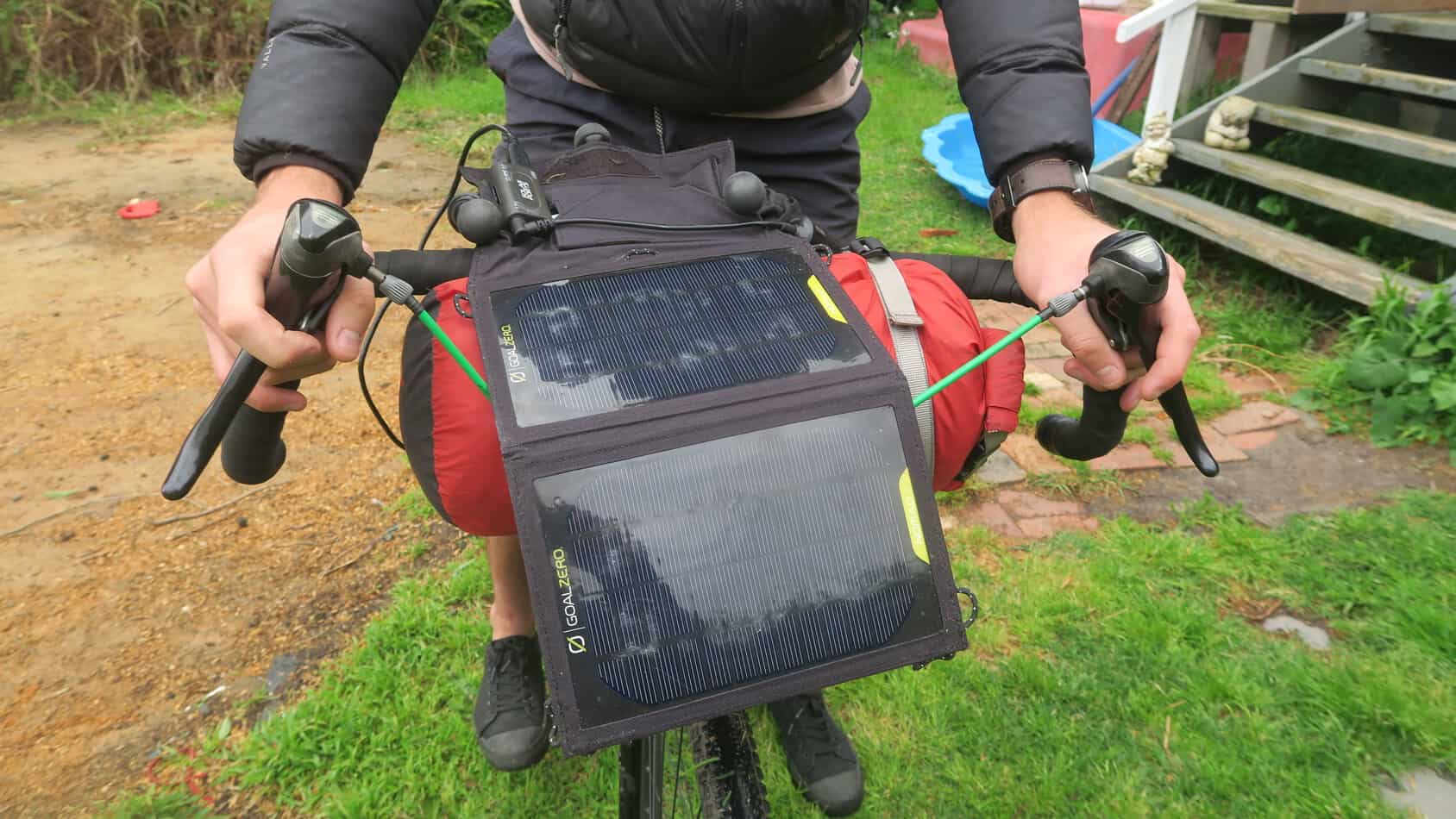Solar panels can be a great addition to any bike touring gear list and make a convenient camping companion. Allowing you do be essentially off the grid, and be up in the mountains charging your devices, to continue to get you on your way.
But it is not all sunshine and rainbows. Whoops. Pardon the pun there! No really using solar panels will come with some setbacks, but if you do your research (or just read the rest of this article) then you should have a good understanding of what to consider in a solar panel for your next adventure. Below is a quick list of the best portable solar panels for camping and your bike touring adventures.
- Goal zero guide 10
- RAVPower 45W
- Anker Powerport Solar 21W
- Suntactics – sCharger-14
- BigBlue 28
Just quick…..
How travel ruined my life!
There’s a profound revelation I’ve stumbled upon in my lifelong romance with travel, one that’s pushed me to question if this love has a darker side.
In my latest video, I take you on a personal journey, sharing an unexpected struggle I’m experiencing – the tug of war between an insatiable wanderlust and an imposed static existence.
In this raw and unscripted narrative, I walk you through my inner battles – the constant wrestling between routine and adventure, the strange ‘travel blues’ that seem to descend when I’m not constantly on the move.
Is there a downside to the exploratory freedom we often laud? Could this relentless pursuit of the new and the unknown have unintended consequences?
I invite you to join me in this introspective journey as we navigate these perplexing questions together.
Are you ready? Click here to watch the video now. Let’s traverse this uncharted territory together.
Okay, let’s get back to the article…
Things to consider when choosing a solar panel for bike touring
One of the main factors to a solar panels’ effectiveness while camping is the weather. As obvious as it may sound, you need relatively sunny weather to power the solar panel. If you are going on a bike tour in a overcast time of year, you can expect to get very little use out of a solar panel.
Depending on what devices you plan to charge with your solar panel will also dictate what type of results you will get. The supply from the solar panel is too erratic for most smartphones and sometimes they don’t charge. If you are charging a iPhone for example they require a voltage above a certain level. When the voltage drops too low it seems to stop charging. With some solar panels it doesn’t start to charge again unless you unplug it and plug it back in.
I recommend and so do many other bike tourers, to charge a large power bank pack with the solar panel, and then this will accumulate power, that you then can use to charge your phone. But depending if you have a solar panel that is able to charge your phone on the fly. Some have experience that, it is more efficient to charge your phone directly instead of charging a battery bank and then charging your phone.
Is it lightweight? For obvious reasons you want a solar panel setup that is small enough and lightweight enough to pack away in your pannier when not in use.
You might want to consider a Dyno Hub, if you have the budget this method of charging on a tour is more expensive. But much more reliable. Depending if the weather is no good, a solar panel won’t be all that efficient. But a Dyno Hub will generate power as long as you’re moving. One of the better ideas about these is that you don’t have to worry about your lights running out as they always stay charged.
The watt amount of your solar panel is also important, you don’t want a small solar panel that only pumps out a couple watts. Most bike tourers use anything around 20 watts or higher. Also depending on your charge load you could get away with a lower amount like a 10W.
It is important to note, that some solar panels may not be able to charge certain devices that require a certain type of amps.
That leads me onto the next factor. How many devices and gadgets are you taking with you? Are you filming videos of your cycling adventures for YouTube? Or just need to charge your phone for directions? If you are producing content on the road you need something that will pump some power to charge multiple devices, like, a drone, camera batteries, your phone, and other bits and bobs.
Solar panels are perfect if you are planning to be away from civilisations for a few days. If you are heading of on a week long bikepacking adventure it the mountains, and the weather is forecasted for sunny days, you should be all good.
Keep in mind that solar panels charge your devices slower then the performance you could get out of a wall charge, at a coffee shop of something. The time available to charge is a consideration. So if you have the availability of society then it maybe a better option to just charge at a library or something.
This means you spend much more time sitting in the sun waiting for your phone to charge with a solar panel. But, having that said the point for a solar panel for me is to enjoy the outdoors while still being plugged in.
If you have the solar panel mounted on your bike while riding. The direction your panel is facing to the sun, any shade and other factors when riding around and always changing directions will effect the power you end up accumulating.
Goal Zero Nomad (7, 14, 28) Plus
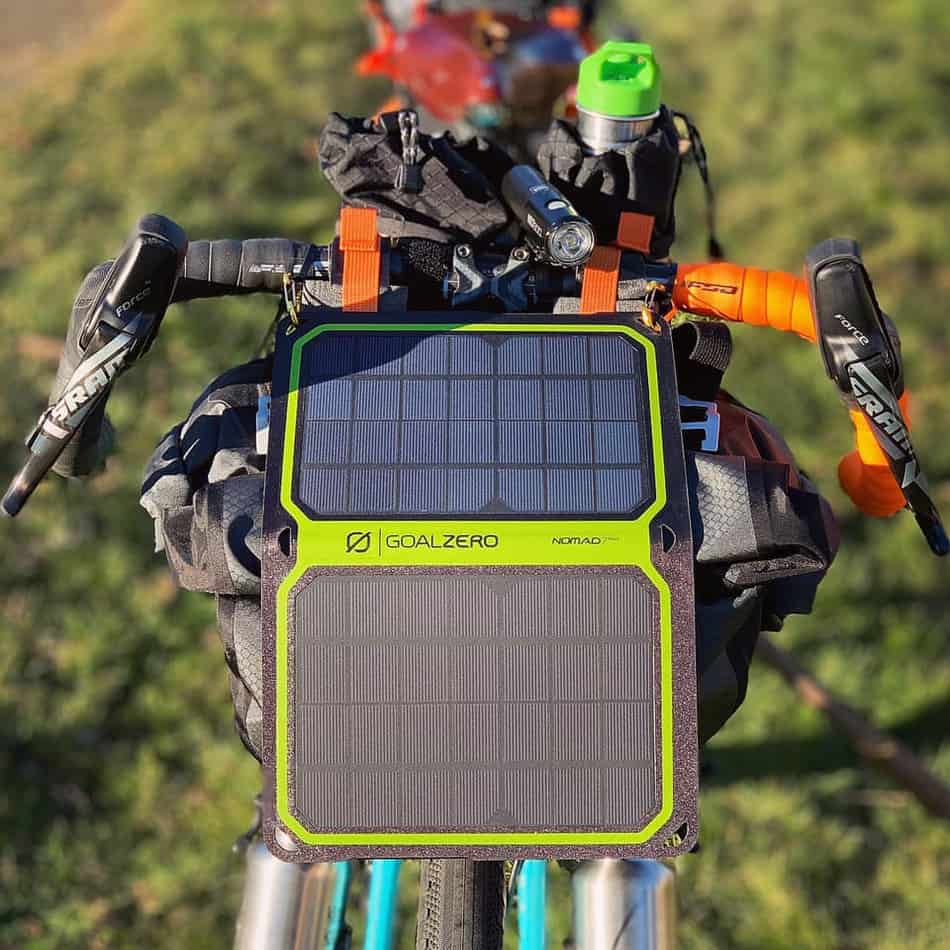
The Goal Zero Nomad Plus range comes in three different models the 7, 14 and 28 watt. Depending on your intended use will depend on what model you get but they are used by bike tourers and recommended.
The Goal Zero Nomad has good mounting holes that make it great to strap to a seatpost bag for charging while on bike. or even like above, my favourite position is on dangling over the front handlebar bag.
For the review of this solar panel I am going to focus on the Nomad 7 Plus. It seems as though this product i popular with some bike travellers. I would like to recommend this solar panel but to be honest I am going to include it in here as a solar panel not to buy. As much as I like Goal Zero as a brand. I don’t want to recommend their products to you. I personally have the Goal Zero Nomad 7 (original version) and after using it for a while it barely charges my tech. Really annoying!
These new Nomad Plus models are good. They have a no-frills construction, good compromise between weight and ruggedness. Cache battery for more reliable charging of sensitive gear. Strong holes for hanging. But it lacks in the power department. Not putting out near as much power that is claimed. It has been tested by other users on a sunny day directly at the sun and only managing to get 3.5 watts out of it.
When charging your phone it would buzz on and off every time under a shade. It seems best to get the battery that comes with it if you are interested in it. Or charge directly to a power bank. However it seems like a hit and miss, some have had good luck with a Goal Zero Nomad 7 and a Guide 10 combo.
It was interesting to find out that Goal Zero and Suntactics seem to be the only camping panels that clarify what type of cells they use. Which are Microcrystalline Silicone, the highest efficiency cells on the market. Suntactics seems to be the better option with better reviews and user experiences overall. We will get to that solar panel soon. Anyway lets get into some better portable solar panel options for your next bikepacking adventure.
RAVPower 24W
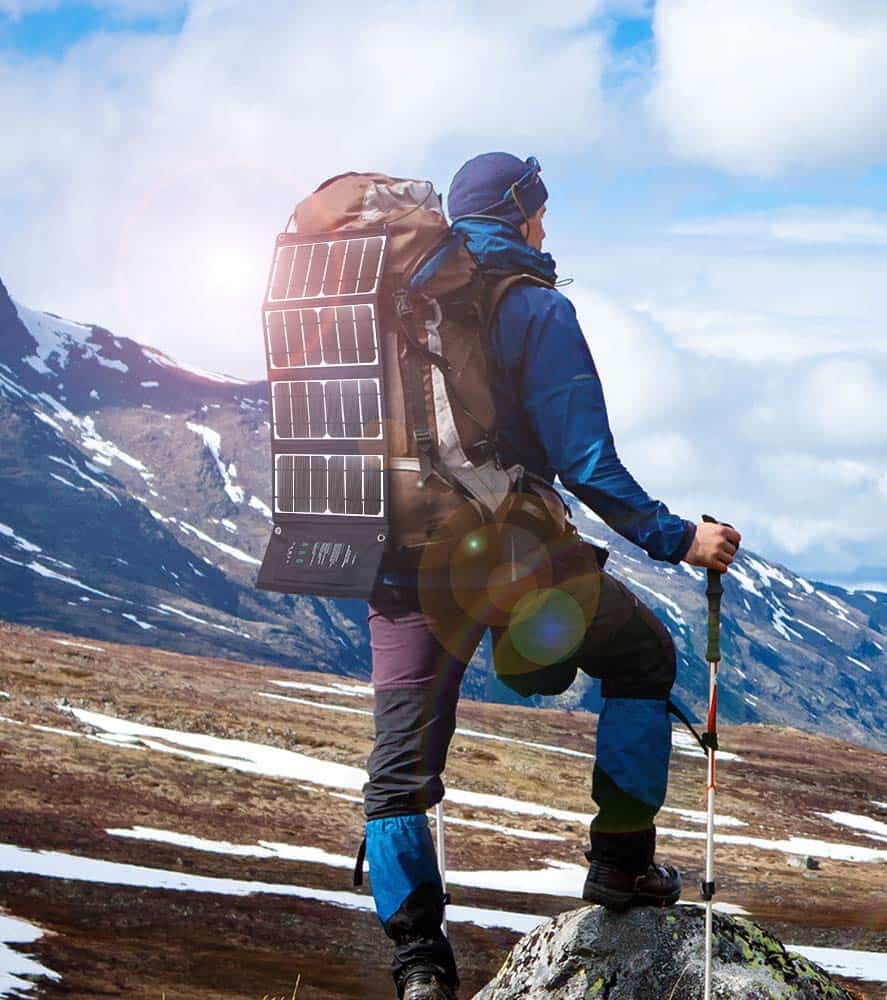
The RAVPower 24W is easy to use, compact enough, comes with hooks and some cables, and it works best in full sun just like any solar panel. But charges things even under cloudy or rainy conditions. Works just as good or even better then the much more expensive Goal Zero panel. Well worth it!
These panels seem to provide such good value for money. The panels are really traveler friendly too; they don’t weigh much (26.5 oz or 750 g) and fold down into a neat little package. It comes with two micro usb cords and a few carabiner clips.
Has the option to charge 3 devices with a large storage pocket. It is a rally good solar charger especially in more overcast, cloudy conditions. It managed to charge a iPhone from 0% to 15% in one hour in very cloudy conditions. However, some users have mentioned that they would like to see improvements, with this chargers efficiency when there is low sun. But at the end of the day, this is a general draw back to all solar panels, is the ability to charge with minimal sun.
One thing to remember is this solar panel is not waterproof, it is advertised as water resistant, but it is not going to stand up to water on the panels.
This is one of the solar panels that stops charging your device, especially iPhones, if there is an interruption of solar charging. For example the iPhone 6 Plus will stop charging; hence, you will have to unplug and plug it back again. A minor con to this charger but again it is common with most solar chargers.
Don’t for get to get the external battery. As this device has smart tech that allows direct plug and play, but if you want to make sure your charge is uninterrupted due to a cloud or anything of that sort, just go ahead and grab an external battery and hook it up to this then run your device through the battery. The RAVPower 20100mAh Power Bank, has a AC Outlet Power option meaning that you can plug in your laptop wall charger and get charge on your laptop to write blog posts or edit youTube videos when you our out in the middle of nowhere!
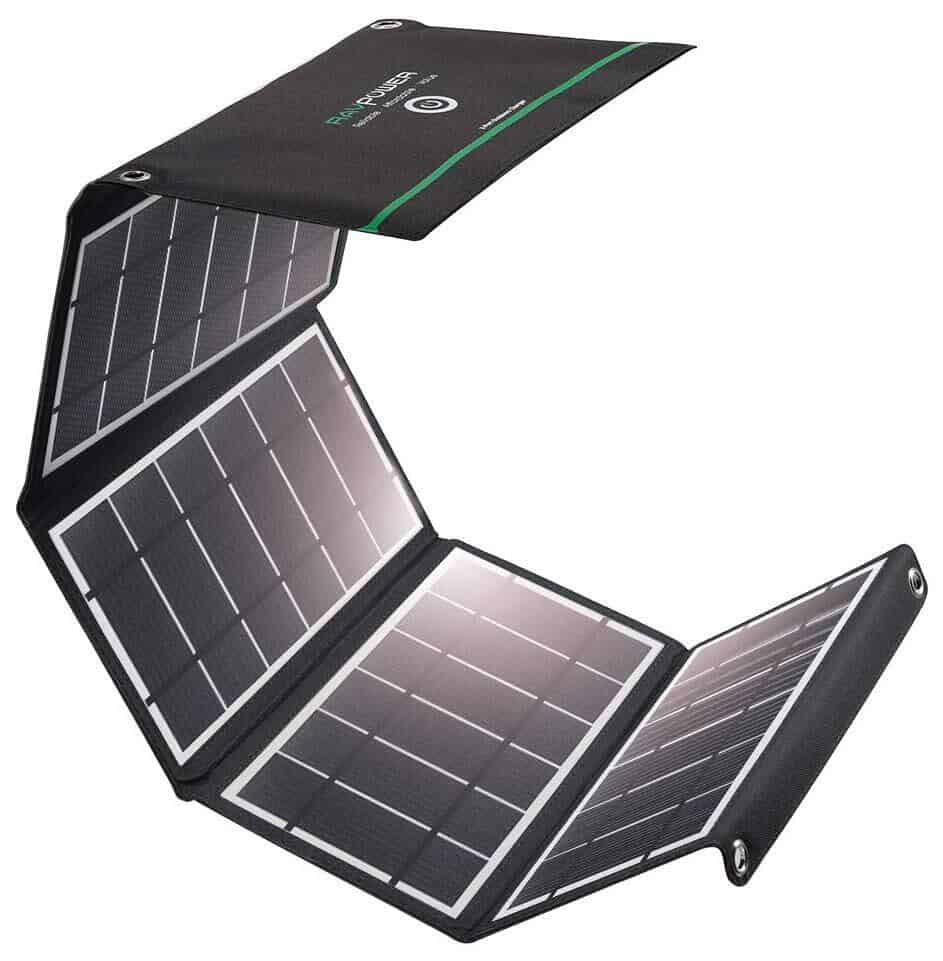
The RAVPower 24W Solar Panel is a more affordable option at $69.99 on Amazon. Making it one of the better solar panel options for camping and your next cycling adventure!
Anker Powerport Solar 21W

The previous solar panel comes with 4 panels when this Anker Powerport Panel comes with three. Making it a smaller panel if you wish to mount it on your bike while charging, one less panel to flop around.
On first impressions of the solar charger the material is a very quality and hefty feel. On all four corners you get the option to mount it with carabiners. Has a velcro closed pouch on the side to store your devices and two usb ports.
From experience with trying to chase the sun all day when it was sunny out and trying to charge a 20,000 mAh batter pack only managed to get 2 bars charged on the bank. As good as some people say this solar panel is it is not the best option out there. Especially for the more expensive price at $139.99 on Amazon, we can suggest a better solar panel for the money.
A user did a test on this panel to see how well it performs. The results are as follows; a galaxy s7 edge was used in this test. “At first I was nervous because I was using the usb cable it came with and it only charged 2% in 20 minutes. So I switched my own usb cable and saw the difference instantly. I was on my porch and it got cloudy and charging estimated time was 3+hours. When the sky cleared out charging time changed to 2+hours. Then I moved the charger to my bedroom window and apparently the Sun hits better there because charging time changed to 1+hours. Phone was charged 100% within estimated time.”
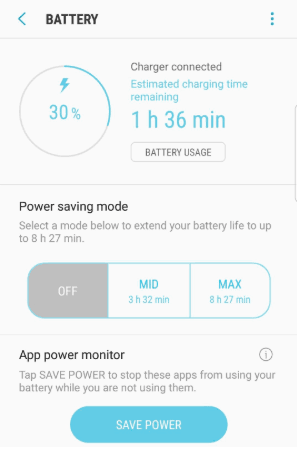
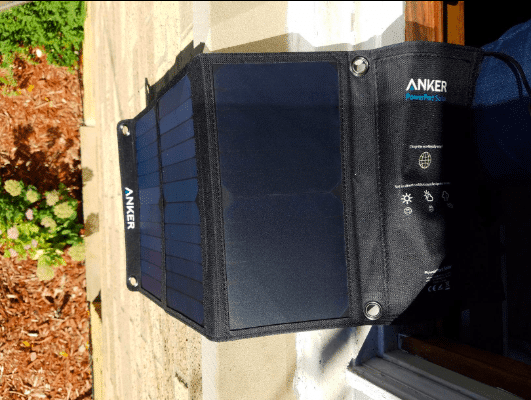
Suntactics – sCharger-14

The Suntactics sCharger 14 is different then most of the other solar panel options. As it is not designed to be mounted, with no pocket storage. it does have hook loops on each corner, so you could use it if you want to charge while riding your bike.
This device performs reliably day day in and day out. Efficiency of this product is breathtaking. Well worth the money. It is American made. Compared to many other brands including Anker and Goal Zero, this panel beats the competition when it comes to output and size/ weight.
Previous owners of the sCharger 5 from 3 years ago, still highly recommend that product as it continues to deliver to this day. Since then this new panel has the same sturdy design but the size of an iPad tablet. Out of the box the 14 is “dripping with raw power coming from “just” the sun!” It even charges electronics in full cloud cover while raining lightly!
Also they mentioned that, it is light weight, easy to lug around and very versatile. Good construction, nicely encased that water is not an issue. Must be directed just right towards the sun in order to maximize the performance. Still though, it works well in indirect light. You get what you pay for, not complaints
Was able to charge a iPad in three hours, that is starting at 3%, same as if I plugged into an outlet. In very poor lighting conditions, the sCharger-14 delivered 0.37 amps versus 0.13 amps for the Goal Zero Nomad 10.

Seems like a very good option for someone looking to use for camping and getting away on a multi day bike adventures in the wilderness. Costing $159.95 on Amazon from others experiences with this solar panel it is worth every penny!
BigBlue 28W

The last solar panel i wanted to include in this post is the BigBlue 28W. This is another option that I can recommend for you if you are looking to use on a bike tour. My mate, Eric has this solar panel and he took it on a Europe bike tour, where we explored mostly the UK. Ans as my Nomad 7 was not preforming well, we were both relying on it to charge our devices. And it worked exceptionally well, I was super impressed. He was charging his phone, power bank, laptop (through USB-C) and my phone too.
The Industrial-strength PET polymer fabric protects your panel from rain and fog, making it waterproof to a (IPX4 waterproof level). However the USB ports are not. They are hid away nicely in a zip pocket design, compared to other velcro ones on the market.
Only cost $59.99 on Amazon, with a 4 out of 5 star rating with 312 rating.
Solar Panel + Power Bank Combination
Recommend you get something like a 20,000 mAh power bank to accommodate your solar panel, any of the solar panel options above plus these power banks, will be a substantial off the grid charging setup.
With a power bank you want to try and get one that has the ability to be powered with a USB C input, resulting in a quick charge. If by now you want to avoid solar panels, again depending on your travel plans. You might be able to get by with just a couple lightweight and powerful power banks, providing power for days. If you go this route you are best to find somewhere to charge the banks over night. As most 20,000 mAh power banks typically take 8 hours or so to charge.
Solar panels are not entirely necessary if you are planning to go from powered camp site to powered camp site. But for me there s no real adventure in that. I prefer to explore the unknown wilderness and requires wild camping, so it always helps to have a off the grid solar panel charge setup as a back.
One thing I would like to see in the ultimate solar panel charger is if they would build in a battery pack, that has the option to charge while charging other devices. But this could use potential power that could be used to charge devices, but lets see what happens.

